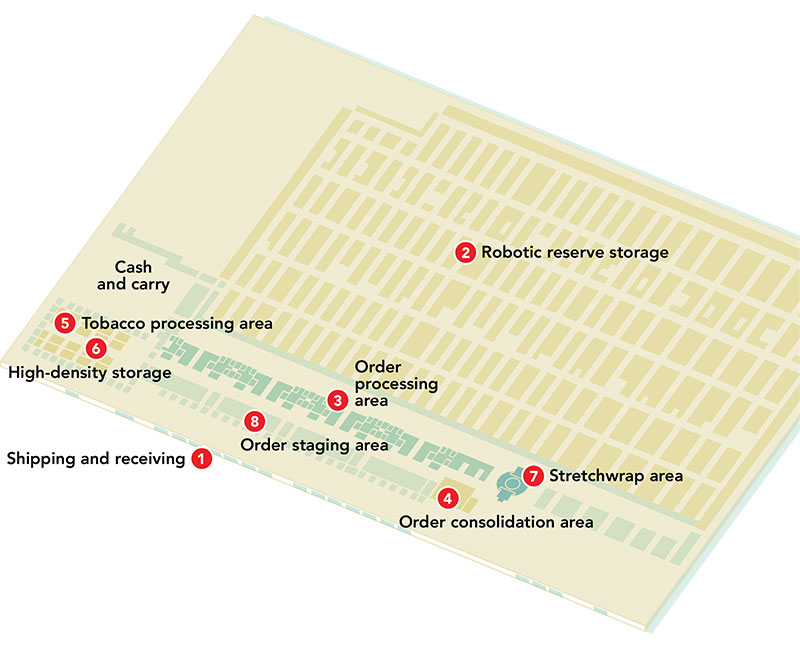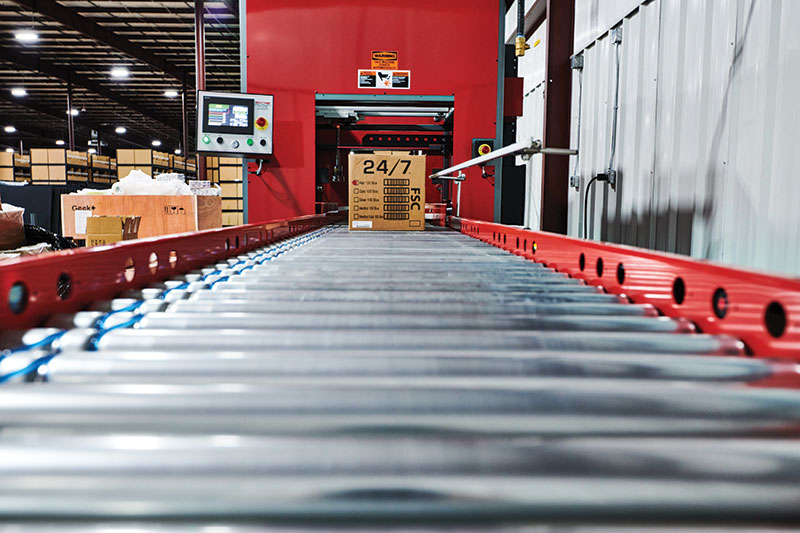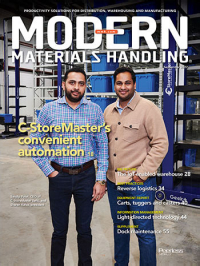Inside C-StoreMaster’s DC: Convenience store distribution simplified
At its new Huntsville, Ala., distribution center, C-StoreMaster has created stripped down and simplified processes to serve its customers.
C-StoreMaster
Location: Huntsville, Alabama
Square Footage: 135,000 square feet
Products Handled: Tobacco, beverages and other products sold in convenience stores
SKUS: 5,000
Throughput: Up to 200,000 line items per shift
Days/Week, Shifts/Day in Operation: 1 shift per day, 5 days per week
Read the full feature story on C-StoreMaster’s Convenient automation
The processes at C-StoreMaster were designed to minimize the number of times a product is touched and maximize efficiency. It’s a deceptively simple design that makes optimal use of robotics.
Receiving: Incoming product is unloaded in the shipping and receiving area (1) with a manual lift system from trucks and vans and placed on a pallet. The product is then entered into the warehouse management system (WMS) as ready for putaway.
Putaway: Pallets are transported by a pallet-handling autonomous mobile robot (AMR) and putaway into the robotic reserve storage area (2). It’s now available to promise. About 60% of the merchandise in the facility is stored at the pallet level and picked from the pallet.
Picking: Convenience store items are bulk picked and item picked at workstations in an order processing area (3). There are distinct processes for bulky items like beverages, general merchandise, and tobacco. Similarly, items are batch-picked during the day, and then consolidated in the evening in a consolidation area (4).
Bulk items: To pick bulk items, including beverages, pallets are retrieved by robots from the reserve storage area and delivered to a workstation in the order processing area, where they are picked to pallets. The idea is to have bulky and heavy items on the bottom of the pallet.
General merchandise items: Pallets with general merchandise items are delivered to the pick area, where items are picked into totes on shelving units. The units are then delivered by AMRs to a high-density storage area.
Tobacco: Tobacco is the most complex process because every state has its own regulations. Cartons have to be stamped according to the state. For that reason, there is a separate area (5) for processing tobacco products. The robots deliver cigarettes, and other tobacco products, in sequence so they can be batched stamp by state and stored in appropriate totes. Those totes are then put back by the case-handling robots into the high-density storage area (6). These robots can store totes up to 15-feet high.
Merge: In the evening, the pick stations become merge stations (3). Pallets that will need to be delivered the next day are delivered to the merge area. Robots then bring general merchandise and tobacco totes in sequence for the individual pallets. The heaviest items always go on the bottom of the pallet, while cigarettes always finish off a pallet. Once a pallet is built, robots deliver it to the stretchwrap area (7) and then to a staging area (8) where pallets are staged in sequence for loading onto outbound trucks.
Shipping: Once all of the pallets for the day are stretchwrapped and staged, they are ready to be loaded onto trucks. The customer relationship management (CRM) system has functionality to load trucks in sequence by route and order. The trucks have QR codes that the robots use to identify the right truck for a pallet, as well as the right storage slot inside the truck. Manual intervention might be required if a robot is not able to successfully load a pallet. Trucks are now ready for delivery.
Delivery: Pallets are delivered the next day to customers. Other trucks go to satellite warehouses that might serve more remote areas. There, the orders are manually unloaded and then placed into smaller vehicles, like vans, for delivery.

System suppliers
- Autonomous Mobile Robots: Geek+
- Customer Relationship Management and Warehouse Management System: C-StoreMaster
- Stretchwrappers: Wulftech

Article Topics
AMR News & Resources
Autonomous mobile robots (AMRs) on a mission Automotive materials handling: The calm after the storm C-suite Interview with Paccurate’s James Malley: The golden age of supply chain technology Conveyco unveils All-Temp AMRs that can move between frozen, chilled and ambient warehouses Seegrid Unveils New, Greater Height and Heavier Payload Palion™ Lift CR1 Autonomous Lift Truck at MODEX 2024 Retail distribution closes in on the customer Research Report: 2024 Warehouse Outlook & Trends More AMRLatest in Materials Handling
Registration open for Pack Expo International 2024 Walmart chooses Swisslog AS/RS and software for third milk processing facility NetLogistik partners with Vuzix subsidiary Moviynt to offer mobility solutions for warehouses Materials Handling Robotics: The new world of heterogeneous robotic integration BSLBATT is looking for new distributors and resellers worldwide Lucas Watson appointed CSO for Körber’s Parcel Logistics business in North America Hyster recognizes Dealers of Distinction for 2023 More Materials HandlingAbout the Author
Subscribe to Materials Handling Magazine

Find out what the world's most innovative companies are doing to improve productivity in their plants and distribution centers.
Start your FREE subscription today.
April 2024 Modern Materials Handling

Latest Resources












